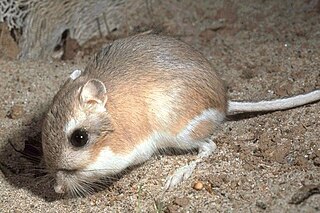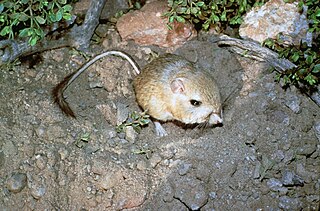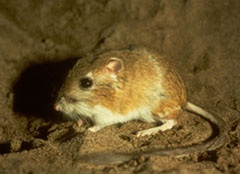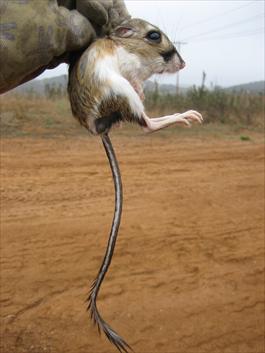
Kangaroo rats, small mostly nocturnal rodents of genus Dipodomys, are native to arid areas of western North America. The common name derives from their bipedal form. They hop in a manner similar to the much larger kangaroo, but developed this mode of locomotion independently, like several other clades of rodents.

The giant kangaroo rat is an endangered species of heteromyid rodent endemic to California.

Heteromyidae is a family of rodents consisting of kangaroo rats, kangaroo mice, pocket mice and spiny pocket mice. Most heteromyids live in complex burrows within the deserts and grasslands of western North America, though species within the genus Heteromys are also found in forests and their range extends as far south as northern South America. They feed mostly on seeds and other plant parts, which they carry in their fur-lined cheek pouches to their burrows.

Dipodomyinae is a subfamily of heteromyid rodents, the kangaroo rats and mice. Dipodomyines, as implied by both their common and scientific names, are bipedal; they also jump exceptionally well. Kangaroo rats and mice are native to desert and semidesert ecosystems of western North America from southern Canada to central Mexico. They are generally herbivorous foragers, and dig and live in burrows.

Ord's kangaroo rat is a kangaroo rat native to western North America, specifically the Great Plains and the Great Basin, with its range extending from extreme southern Canada to central Mexico.

The agile kangaroo rat is a species of rodent in the family Heteromyidae. It is endemic to southern California in the United States.
The California kangaroo rat is a species of rodent in the family Heteromyidae. However, populations are declining, having not fully recovered after the drought in California from 2013 to 2015 destroyed their habitat and changed it into desert.

The Gulf Coast kangaroo rat is a species of rodent in the family Heteromyidae found in Mexico and the state of Texas in the United States. Its appearance and ecology are very similar to those of its putative sister species, Ord's kangaroo rat.

The desert kangaroo rat is a rodent species in the family Heteromyidae that is found in desert areas of southwestern North America. It is one of the large kangaroo rats, with a total length greater than 12 inches (300 mm) and a mass greater than 3.2 ounces (91 g).

The San Quintin kangaroo rat is a species of rodent in the family Heteromyidae. It is endemic to Mexico, where it is known only from western Baja California. Its natural habitat includes arid lowlands with sparse vegetation.

Heermann's kangaroo rat is a species of rodent in the family Heteromyidae. Their long smooth pelage resembles typical kangaroo rats, with their dorsal side showing a mixed range of olive, black and orange colors. There are 9 distinguished sub-species of Dipodomys heermanni: D.h. arenae, D.h. berkeleyensis, D.h. dixoni, D.h. goldmani, D.h. heermanni, D.h. jolonensis, D.h.morroensis, D.h. swarthi, and D.h. tularensis. The dental formula of Dipodomys heermanni is 1.0.1.31.0.1.3 × 2 = 20.
The San José Island kangaroo rat is a subspecies of rodent in the family Heteromyidae. It is endemic to Mexico, where it is found only on San José Island off the east coast of Baja California Sur. is restricted to an area of only 30 km2 in the southwestern coast of San José Island, Lower California, with the population having been drastically reduced in size and being close to extinction No other species of Dipodomys occur in sympatry with D. insularis.

Merriam's kangaroo rat is a species of rodent in the family Heteromyidae. The species name commemorates Clinton Hart Merriam. It is found in the Upper and Lower Sonoran life zones of the southwestern United States, Baja California, and northern Mexico.

Nelson's kangaroo rat is a species of rodent in the family Heteromyidae which is endemic to the central plateau of Mexico.

The Fresno kangaroo rat or San Joaquin kangaroo rat is a species of rodent in the family Heteromyidae. It is endemic to areas within and near the San Joaquin Valley of California in the United States. Habitat destruction due to agricultural development and urbanization has put this species at risk, and the International Union for Conservation of Nature has assessed its conservation status as "vulnerable".

The Panamint kangaroo rat is a species of rodent in the family Heteromyidae. It is endemic to the Mojave Desert in eastern California and western Nevada, in the United States.

Phillips's kangaroo rat is a species of rodent in the family Heteromyidae. It is endemic to Mexico. Its natural habitat is hot deserts.

The banner-tailed kangaroo rat is a species of rodent in the family Heteromyidae. It is found in arid environments in the southwestern United States and Mexico where it lives in a burrow by day and forages for seeds and plant matter by night.

Stephens's kangaroo rat is a species of rodent in the family Heteromyidae. It is endemic to the Southern California region of the United States, primarily in western Riverside County. The species is named after American zoologist Frank Stephens (1849–1937).
The Dulzura kangaroo rat, or San Diego kangaroo rat is a species of rodent in the family Heteromyidae. It is found in Baja California, Mexico, and in the Colorado Desert and elsewhere in California in the United States. It is a common species and the IUCN has assessed its status as being of "least concern".















